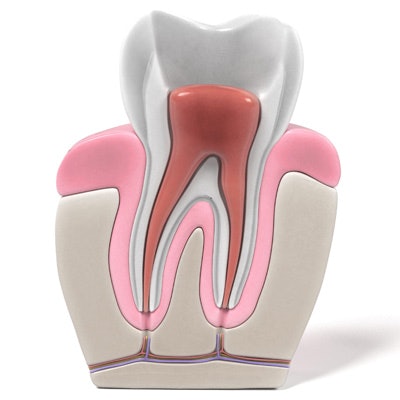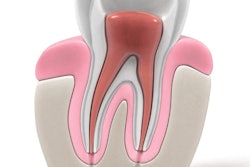
Researchers tested two rotary instruments and one manual file side by side to see which was able to remove the most residual filling material after failed endodontic therapy. The comparison resulted in a striking clinical preference.
The rotary instruments outperformed the manual files in removing this material, even if none of the three systems was able to remove all of it, according to a new study of three systems from Dentsply Maillefer: the ProTaper Universal rotary instrument, the ProTaper Retreatment rotary instrument, and the Hedström manual files.
"Considering the time required and the amount of the filling removal, ProTaper Retreatment were not superior to ProTaper Universal, but both rotary instruments were more effective and less time-consuming than Hedström manual files," the authors wrote (Indian Journal of Dental Research, July-August 2017, Vol. 28:4, pp. 400-405).
The lead author was Luiz Fernando Fariniuk, PhD, from the endodontics department at Pontifical Catholic University of Paraná School of Health and Biosciences in Curitiba, Brazil.
Which is best?
When root canal retreatment is necessary, nonsurgical treatment is preferred if disinfection can be improved and the root canal properly filled, according to previous research. Ongoing infection due to inadequate cleaning and root canal filling has been found to be the main cause of root canal treatment failure.
Previous studies have found the use of rotary instruments to be effective, safe, and time-saving for removing gutta-percha. The current study compared the use of three systems that have not been examined head to head before.
The ProTaper Universal system, while intended for root canal preparation, has also been recommended for root canal filling removal, according to the authors. The ProTaper Retreatment is a set of three instruments of different lengths, multiple and progressive tapers, and various apical diameters each designed for removing filling materials from the cervical, middle, or apical thirds of the root canal. The researchers also included the Hedström manual files in their comparison.
The investigators obtained 36 extracted human mandibular teeth with mature apices 18-mm and 22-mm long. They used preoperative mesodistal and buccolingual radiographs to verify that each tooth had one straight visible canal without calcifications or resorptions. After the root canal preparation in all the teeth, they stored the teeth at 37° C for six months to approximate clinical conditions.
The teeth were divided into three groups of 12. The coronal restoration in all teeth was removed using high-speed round burs. The root filling material was removed with a crown-down technique using the following instruments:
- ProTaper Universal rotary instruments at 350 rotations per minute (rpm): F5 (size 50, 0.05 taper), F4 (size 40, 0.06 taper), F3 (size 30, 0.09 taper), and F2 (size 25, 0.08 taper) finishing instruments were used or up to the first instrument that reached the working length. F3 and F4 performed apical widening, finalized by F5 (size 50, 0.05 taper).
- ProTaper Retreatment at 350 rpm: D1 (size 30, 0.09 taper), D2 (size 25, 0.08 taper), and D3 (size 20, 0.07 taper) instruments were used in that order, and F2, F3, F4, and F5 instruments were used for apical repreparation.
- Hedström manual files and Gates-Glidden burs (Dentsply Maillefer): Sizes 3, 2, and 1 were used to remove filling material from the cervical and middle thirds of the root canals, following by putting solvent into the root canal to soften the gutta-percha. The files were used with a filing motion (1-mm to 2-mm push and pull) up to the size that reached the working length. Then apical repreparation was performed with the files until size 50 at working length until no additional root canal filling material could be recovered on this file.
The researchers sectioned the specimens for scanning and used the resulting images to measure the area of the residual filling material.
Some material was left on the canal walls in all three groups. The ProTaper Universal group had the smallest amount of filling left, and the manual files had the largest amount, which were significantly different from each other (p < 0.05). However, the size of the remnants in the two ProTaper groups were similar.
| Filling material remnants by instrument | |
| Instrument | Mean mm2 |
| ProTaper Universal | 0.68 |
| ProTaper Retreatment | 0.77 |
| Hedström manual files | 1.56 |
The time for the manual file group to reach working length and total time for retreatment was significantly greater than in the other groups, whereas the time for retreatment after reaching working length was similar among the three groups. Additionally, the total time for retreatment was similar with the two rotary systems.
| Mean time for retreatment by groups (in seconds) |
|||
| Time | ProTaper Universal | ProTaper Retreatment | Hedström manual files |
| Time to reach working length for shaping | 170.00 | 156.25 | 462.83 |
| Time for retreatment | 266.17 | 307.00 | 300.25 |
| Total time | 436.17 | 463.25 | 763.08 |
If you only buy 1
The ProTaper Retreatment instruments were designed to make filling removal faster and safer, although the ProTaper Universal instruments performed similarly in terms of time and amount of filling removed, according to the authors.
This study used only the ProTaper Universal finishing instruments for filling removal, since the ProTaper Universal instruments showed a high rate of fracture with its shaping instruments for retreatment in the past. While no fractures occurred in the current study, plastic deformation occurred with some instruments and they were replaced, they noted.
"Since the time required and the amount of filling removal provided by the ProTaper Retreatment and ProTaper Universal was similar, it might be assumed that using only the ProTaper Universal instruments for both filling removal and repreparation could simplify the procedures," the authors concluded.



















